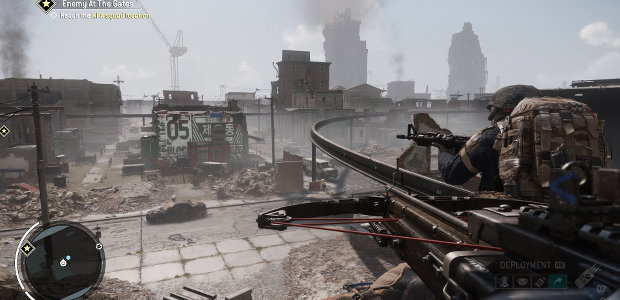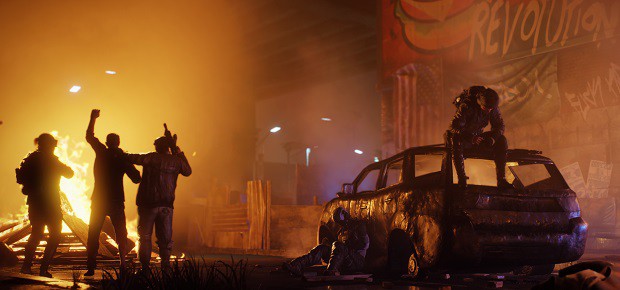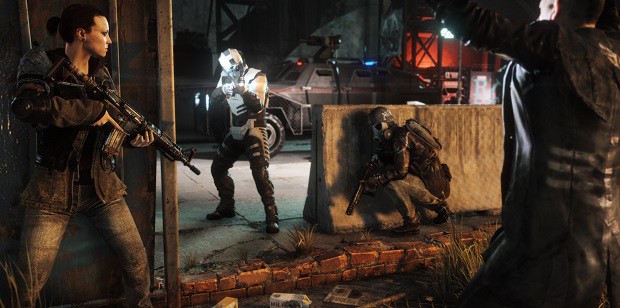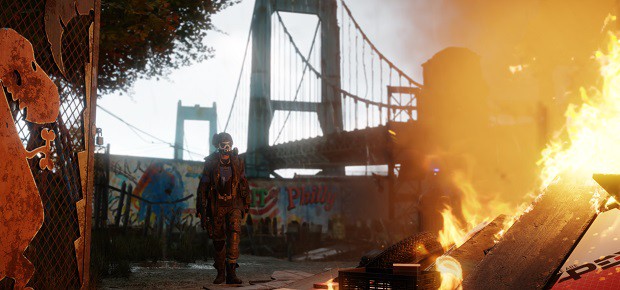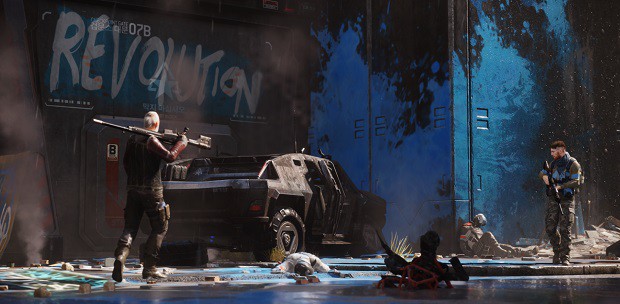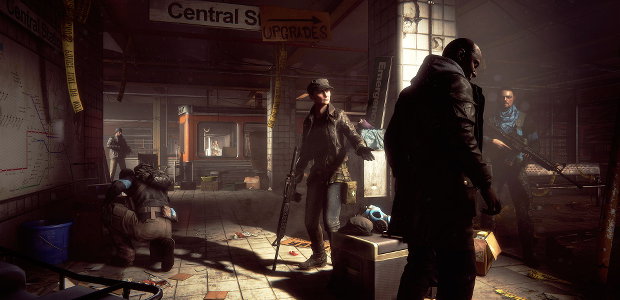Homefront: The Revolution Wants To Make America Great Again
But can it survive comparison with Far Cry?
Homefront: The Revolution [official site] is a surprisingly sophisticated game. New developer Dambusters has assembled a thoughtful open world shooter that mixes the DNA of a Far Cry gunfight with the dented, jury-rigged science fiction of a Metro 2033. On the strength of six hours play it's streets ahead of the Kaos Studios original, despite the project's changing hands twice in two years - airlifted from THQ's collapse by Crytek, only to be torn from Crytek's flailing grasp by co-publisher Deep Silver. But it does feel rather conservative for a game about toppling the Powers That Be.
A few hours into the game, a character declares: “If fighting is a mistake I'm going to keep making it, because it's all I know how to do!” Back in 2005 this might have been hailed as a rare piece of self-commentary; nowadays, it feels like somebody signing a disclaimer. Ah yes - the routine self-aware gasp of a blockbuster writing team trying to account for a universe in which slaughtering folk by the dozen is the only meaningful action. Old Man Murray once set out to score games by how long it takes you to find a crate. Perhaps we should invent a new version of that, for those moments when a grizzled ally winks at you and says “man, these wave defence missions are getting pretty repetitive, aren't they?”
Thankfully, The Revolution is good for more than a few wave defence missions, even if it does have that conservative streak. It's formulaic to an extent and it's also rather comfortable for a game with survivalist pretensions. The Revolution casts you as an American resistance fighter, making ends meet in an alternate universe where a unified, high-tech Korea has overrun a debt-crippled US. Its setting is one part real-life Philadelphia to one part The Man In The High Castle: think red banners flapping against townhouses, Vichy-style American puppet government, and goons in usefully dehumanising facemasks roughing up nice old ladies on the corner.
Some eccentric NPCs notwithstanding - consider Exhibit A, the chap who broke off to deliver a canned greeting while an enforcer held him against a wall - it's a fairly plausible vista. But there are also inexhaustible ammo depots for your exclusive use, and medical cabinets packed with healing syringes that'll magically expel all the bullets from your body.
One of the first things you're given is a pistol you can transform into either an SMG or a hold-and-release pneumatic assassination weapon, snapping the components together in real-time. Each of The Revolution's guns (you're allowed two at once, plus a sidearm) is actually three guns – in addition to standard accessories like scopes and stocks, you buy blueprints for exotic alternates such as a limpet mine launcher and crossbow. Reassembling a rifle into an LMG when the chips are down is a thrill, but as in Ubisoft's The Division, the gulf between the arsenal's swagger and the plot's talk of scraping by is irksome. It's hard to think of yourself as punching up from the gutter when you're functionally a Crysis-brand cyborg in scrappy denim.
This isn't to say that you can just stride into buildings and twitch-shoot your way to the top. Not all the time, anyway. The Revolution's sandbox is more rigorous than those of Ubisoft, though it's constructed around the same rhythm of conquering hotspots to unlock nearby upgrade resources and missions, populating a world map with icons while dealing with the odd time-sensitive emergent activity. It also comes in several flavours. The Green Zone, which I've yet to visit, is the home of the Korean elite. The Red Zone is the side of Philadelphia where the rebels hold most sway, an undulating waste of minced brick studded with the sleek pop-up fortifications of the invading power, in which roving NPCs are continually at each other's throats.
It's a grubby, unromantic landscape, brought to life with that somewhat sterile photorealism that seems to be a CryEngine hallmark, and the missions aren't remarkable – a question of nobbling a number of snipers, or reaching a terminal so you can play a rudimentary hacking minigame to claim a base. But a couple of things change the tempo.
One is that The Revolution is a parkour game, with routes up buildings draped in blue, so ambushing a convoy or infiltrating a position needn't be as humdrum as sliding along a wall. It's no Titanfall or even Dying Light but there's a nice sense of possibility to the industrial district in particular, with butchered factories linked by colossal industrial pipes, and resources squirrelled away in signal towers.
The other point of departure from the Ubiformula is that Red Zones are patrolled by airships, drifting monsters armed with spotlights that bellow like Bioshock's Big Daddies when they clock you, triggering a wave of ground attackers. They're supported by small aerial drones that'll alert the mother blimp unless you swat them quickly. It's both a way of nudging the emphasis towards stealth and a pleasantly oppressive ambient flourish, like foraging in the shadow of an enormous jackboot, ready to fall.
Escaping a situation gone south is straightforward enough – just break line of sight, then leave the vicinity – but every so often you'll be tempted to dig in, and the game will punish you for that bravery/stupidity by sending robot tank reinforcements and juggernauts in heavy armour. Thankfully, the same slight concept-execution disconnect behind those transforming guns also equips you with sorcerous “hacker” grenades that briefly flip robot allegiances, and the heavies wear explodable backpacks. You can also recruit another rebel as a buddy to run interference - there are co-op missions for up to four that take place in the same environments, but they're portioned off from the main campaign.
The story eventually takes you to Yellow Zones, where the feel shifts even further towards stealth. These are relatively placid areas inhabited by civilians in need of a jolly sound radicalising. There are no other resistance fighters to call on here, and the security is closer to that of a Metal Gear game, with map-wide alerts that oblige you to lurk in portaloos and dumpsters till guards decide that the heavily armed maniac they saw was a figment of the imagination. Rather than simply gunning the “Norks” down (I'm not sure if the in-game slang for North Koreans is a reference to Orcs, breasts, both or neither), your job is to win over the locals by, basically, doing some open world busywork.
There are prisoners to rescue, propaganda vehicles to smoke, generators to sabotage and People's Army house raids to thwart, amongst other rabble-rousing oddjobs, each of which fills a “Hearts and Minds” gauge. Get 100% of the residents on-side and you can unleash a fullscale revolt that, in turn, unlocks a final assault on the area's military HQ. It's a very mechanical kind of uprising, but the implementation is lively - well-ordered street scenes become tattered and unruly as you stir things up – and the change of pace is worthwhile even if the Yellow Zone activities are pedestrian in themselves.
It's in Yellow Zones, moreover, that you pick up on the sophisticated story about occupation that might have been, or perhaps may yet be. There are conversations to overhear about the invader's methods – a man piqued by the lack of American sports on Korean state TV, for example, who rather complacently argues that it would be the perfect distraction for a restless populace. One of the lategame areas is a prison, where you'll skirt the edges of a cage fight while searching for a saferoom, and of course there are the inevitable journal entries to fill in the backstory. The seeds of an intriguing portrayal of a crushed and divided society are in place, but it remains to be seen whether the systems will give them room to grow.
Speaking to me after my hands-on, narrative designer and history buff Stephen Rhodes waved away the thought that The Revolution has anything directly to say about the USA's understanding of the outside world in this, the glorious era of Donald Drumpf. But he did concede that the game is in part a response to US foreign policy, exploring how a country that has made a habit of embedding soldiers overseas would feel if the situation were reversed.
“There are definitely parallels there with how America is perceived abroad, and how America perceives itself, and how those things are twisted and changed in our timeline to facilitate this scenario,” Rhodes told me. “And it's really interesting to look at how the American people respond to foreign troopers, foreign involvement, how you can imagine American people reacting in today's world.” Indeed. I hope there's scope to follow through on all that, between dusting APCs with hacker pheromones, and raking up scrap to build grenades with.
I enjoyed Homefront least when it came to a later story mission, in which I and a grouchy man in a leather jacket infiltrated a harbour facility to abscond with a tank. The area itself is a wonder – two listing US aircraft carriers, gradually being pulled apart by a small, hopeless army of serfs. Truly, a fine opportunity to bust out an incendiary launcher while free-running across a gutted flight deck. A shame, then, that the eventual free-for-all happens on the dock itself, and sees you knocking over RPG troops while your intensely fragile charge powers up. Adding insult to injury, the checkpoint system kept reviving me right in the crossfire. Preceding story missions aren't nearly this wooden – one of them gives you the option of leaping a fortress wall on one of Homefront's unwieldy motorbikes – but it's bothersome, given the spirit of improvisation elsewhere, that Dambusters still has space for an old-fashioned meatgrinder.
Homefront isn't going to set the world alight. It certainly won't win many converts to the business of rolling across a map screen like a viral epidemic, painstakingly exposing and eating away at every last item on the to-do list. But the fiction is eye-catching, and if the majority of story missions are a match for the flexibility of your toolset, and the narrative texture of Philadelphia isn't entirely suffocated beneath the icons, this will be a convincing alternative to Far Cry. For a sequel to a would-be Call of Duty killer best remembered for asking you to hide in a mass grave, that's more than I was hoping for.
Homefront: The Revolution is due May 17th.


